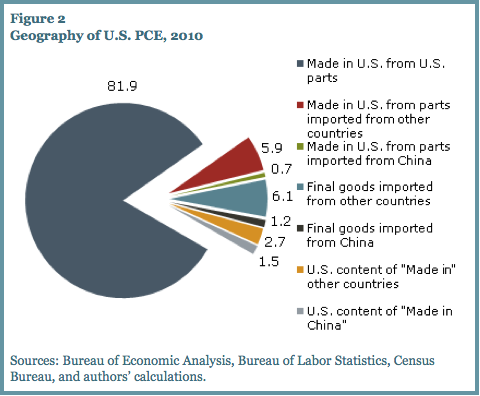Wanna start an interesting discussion at a dinner party? Ask people how much of what we consume in the US comes from or is manufactured in China.
Over the weekend, I had a discussion with a chum from UBS about wide public misconceptions. My example was the idea China is the primary funder of US deficits (They actually fund between 7.5-9.5%). We all kicked around others — where we get our oil, religion & science, source of fiscal deficits, belief in Angels, Laffer Curve, supply side economics, water consumption, etc. — but the most interesting one is how much of our consumption is from China.
A quick search turned up this Federal Reserve Bank of San Francisco research report: The U.S. Content of “Made in China.”
What did they find?
“Goods and services from China accounted for only 2.7% of U.S. personal consumption expenditures in 2010, of which less than half reflected the actual costs of Chinese imports. The rest went to U.S. businesses and workers transporting, selling, and marketing goods carrying the “Made in China” label. Although the fraction is higher when the imported content of goods made in the United States is considered, Chinese imports still make up only a small share of total U.S. consumer spending.”
The Fed researchers fastidiously backed their with deep lots of data sourced from BEA, BLS, and the U.S. Census Bureau. Their conclusion was a surprisingly low number — I would have guessed closer to 10%. But i cannot argue with their data or methodology.
Perhaps a reason for believing China’s share of the US consumer market is how often we see the Made in China label. They dominate the toys, clothing and electronics that get sold in stores like Wal-Mart and Target and Toys-R-Us.
Morgan Housel explained:
“A common rebuttal I got was, “How can it only be 2.7% when almost everything in Wal-Mart (NYSE: WMT ) is made in China?” Because Wal-Mart’s $260 billion in U.S. revenue isn’t exactly reflective of America’s $14.5 trillion economy. Wal-Mart might sell a broad range of knickknacks, many of which are made in China, but the vast majority of what Americans spend their money on is not knickknacks.”
We also spend far more on others than we realize: Housing, Commodities (especially Food and Energy) and Services (Health Care, Financial, Accounting, Education etc.). Housel noted that in 2010, “we spent 34% of their income on housing, 13% on food, 11% on insurance and pensions, 7% on health care, and 2% on education. Those categories alone make up nearly 70% of total spending, and are comprised almost entirely of American-made goods and services.”
That’s one more piece of misinformation put the rest. Now if we can only do something about the Laffer Curve . . .
>
>
Previously
Is China Really Funding the US Debt? (January 14th, 2011)
Sources:
The U.S. Content of “Made in China” (Mirror)
Galina Hale and Bart Hobijn
Federal Reserve Bank of San Francisco, August 8, 2011
http://www.frbsf.org/publications/economics/letter/2011/el2011-25.html
3 Misconceptions That Need to Die
Morgan Housel
Motley Fool, October 25, 2011
http://www.fool.com/investing/general/2011/10/25/3-misconceptions-that-need-to-die.aspx



What's been said:
Discussions found on the web: